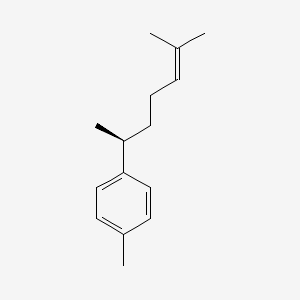| Authors | Title | Published | Journal | PubMed Link |
|---|---|---|---|---|
| Yang S et al. | Carboxy-directed asymmetric hydrogenation of α-alkyl-α-aryl terminal olefins: highly enantioselective and chemoselective access to a chiral benzylmethyl center. | 2014 | Org. Biomol. Chem. | pmid:24569889 |
| Chu SS et al. | Chemical composition and insecticidal activity against Sitophilus zeamais of the essential oils derived from Artemisia giraldii and Artemisia subdigitata. | 2012 | Molecules | pmid:22695231 |
| Podlogar JA and Verspohl EJ | Antiinflammatory effects of ginger and some of its components in human bronchial epithelial (BEAS-2B) cells. | 2012 | Phytother Res | pmid:21698672 |
| Fujiwara M et al. | Biotransformation of turmerones by Aspergillus niger. | 2011 | J. Nat. Prod. | pmid:21189039 |
| Du ZT et al. | A short synthesis of bisabolane sesquiterpenes. | 2011 | Molecules | pmid:21931286 |
| Takigawa H et al. | C(35)-terpenes from Bacillus subtilis KSM 6-10. | 2010 | J. Nat. Prod. | pmid:20085287 |
| Zhao C et al. | Comparative analysis of essential oils from eight herbal medicines with pungent flavor and cool nature by GC-MS and chemometric resolution methods. | 2009 | J Sep Sci | pmid:19212980 |
| Nishikawa K et al. | The bisabolane sesquiterpenoid endoperoxide, 3,6-epidioxy-1,10-bisaboladiene, isolated from Cacalia delphiniifolia inhibits the growth of human cancer cells and induces apoptosis. | 2008 | Biosci. Biotechnol. Biochem. | pmid:18776670 |
| Qin NY et al. | Quantitative determination of eight components in rhizome (Jianghuang) and tuberous root (Yujin) of Curcuma longa using pressurized liquid extraction and gas chromatography-mass spectrometry. | 2007 | J Pharm Biomed Anal | pmid:16930909 |
| Sugimoto N et al. | [Antimicrobial activity and constituents in rumput roman extract as a natural food preservative]. | 2007 | Shokuhin Eiseigaku Zasshi | pmid:17892004 |
| Ehara T et al. | Synthesis of (R)-curcumene and (R)-xanthorrizol based on 1,2-Aryl migration via phenonium ion. | 2007 | Chem. Pharm. Bull. | pmid:17827762 |
| Simonsen HT et al. | Antifungal constituents of Melicope borbonica. | 2004 | Phytother Res | pmid:15305313 |
| Zhang A and RajanBabu TV | Chiral benzyl centers through asymmetric catalysis. a three-step synthesis of (R)-(-)-alpha-curcumene via asymmetric hydrovinylation. | 2004 | Org. Lett. | pmid:15330612 |
| Govinden-Soulange J et al. | Chemical composition and in vitro antimicrobial activities of the essential oils from endemic Psiadia species growing in mauritius. | 2004 | Biol. Pharm. Bull. | pmid:15516729 |
| Antonious GF and Kochhar TS | Zingiberene and curcumene in wild tomato. | 2003 | J Environ Sci Health B | pmid:12856930 |
| Reddy AC and Lokesh BR | Effect of dietary turmeric (Curcuma longa) on iron-induced lipid peroxidation in the rat liver. | 1994 | Food Chem. Toxicol. | pmid:8157223 |
| pmid: | ||||
| pmid:11345708 | ||||
| pmid:18932091 | ||||
| pmid:22167373 | ||||
| pmid:12385876 |
(+)-alpha-curcumene
(+)-alpha-curcumene is a lipid of Prenol Lipids (PR) class.
